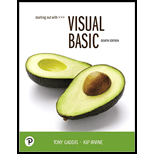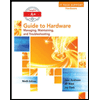
EBK STARTING OUT WITH VISUAL BASIC
8th Edition
ISBN: 9780135205082
Author: Irvine
Publisher: VST
expand_more
expand_more
format_list_bulleted
Concept explainers
Expert Solution & Answer
Chapter 1.1, Problem 1.3CP
Explanation of Solution
Main memory:
- Main memory or Random Access Memory (RAM) is the volatile memory, which means the information stored in that memory would be erased when the computer is turned off.
- Main memory has a limited storage capacity so it cannot store a large amount of data.
- The Central Processing Unit (CPU) directly accesses the data or information stored in the main memory.
- Some of the examples of main memory are as follows:
- RAM (Random Access Memory)
- ROM (Read Only Memory)
- EPROM (Erasable Programmable Read Only Memory)
- PROM (Programmable Read Only Memory)
- Cache memory
- Registers
Secondary storage:
- Secondary storage or secondary memory is the non-volatile memory, which means the information stored in that memory cannot be erased even when there is any mishap in the computer...
Expert Solution & Answer
Want to see the full answer?
Check out a sample textbook solution
Students have asked these similar questions
Generate a random sample of standard lognormal data (rlnorm()) for sample size n = 100. Construct histogram estimates of density for this sample using Sturges’ Rule, Scott’s Normal Reference Rule, and the FD Rule.
Can I get help with this case please, thank you
I need help to solve the following, thank you
Chapter 1 Solutions
EBK STARTING OUT WITH VISUAL BASIC
Ch. 1.1 - List the five major hardware components of a...Ch. 1.1 - Prob. 1.2CPCh. 1.1 - Prob. 1.3CPCh. 1.1 - What are the two general categories of software?Ch. 1.3 - What is an algorithm?Ch. 1.3 - Why were computer programming languages invented?Ch. 1.3 - What is an object? What is a control?Ch. 1.3 - What does event-driven mean?Ch. 1.3 - What is a property?Ch. 1.3 - Prob. 1.10CP
Ch. 1.3 - If a control has the programmer-defined name...Ch. 1.3 - What is the default name given to the first...Ch. 1.3 - Prob. 1.13CPCh. 1.4 - What four items should be identified when defining...Ch. 1.4 - Prob. 1.15CPCh. 1.4 - Prob. 1.16CPCh. 1.4 - Prob. 1.17CPCh. 1.4 - What is pseudocode?Ch. 1.4 - Prob. 1.19CPCh. 1.4 - What is the purpose of testing a program with...Ch. 1.4 - Prob. 1.21CPCh. 1.5 - Prob. 1.22CPCh. 1.5 - Prob. 1.23CPCh. 1.5 - Prob. 1.24CPCh. 1.5 - Prob. 1.25CPCh. 1.5 - What is a ToolTip?Ch. 1 - The job of the _____ is to fetch instructions,...Ch. 1 - Prob. 2FIBCh. 1 - The two general categories of software are _____...Ch. 1 - Prob. 4FIBCh. 1 - Since computers cannot be programmed in natural...Ch. 1 - _____ is the only language computers can process...Ch. 1 - Words that have predefined meaning in a...Ch. 1 - Prob. 8FIBCh. 1 - _____ are characters or symbols that perform...Ch. 1 - Prob. 10FIBCh. 1 - Prob. 11FIBCh. 1 - _____ is data the computer collects from the world...Ch. 1 - Prob. 13FIBCh. 1 - A(n) _____ is a set of well-defined steps for...Ch. 1 - Prob. 15FIBCh. 1 - _____ is human-readable code that looks similar to...Ch. 1 - Prob. 17FIBCh. 1 - Prob. 18FIBCh. 1 - Prob. 19FIBCh. 1 - Prob. 20FIBCh. 1 - Prob. 21FIBCh. 1 - The _____ window allows you to examine and change...Ch. 1 - Prob. 23FIBCh. 1 - Prob. 24FIBCh. 1 - Prob. 25FIBCh. 1 - Prob. 26FIBCh. 1 - Prob. 27FIBCh. 1 - Prob. 28FIBCh. 1 - You can access the full documentation for Visual...Ch. 1 - Prob. 30FIBCh. 1 - What is the difference between main memory and...Ch. 1 - What is the difference between operating system...Ch. 1 - What is an object?Ch. 1 - What is a control?Ch. 1 - Prob. 5SACh. 1 - Prob. 6SACh. 1 - What is an object? What is a control?Ch. 1 - Prob. 8SACh. 1 - Prob. 9SACh. 1 - Prob. 10SACh. 1 - Prob. 11SACh. 1 - Prob. 12SACh. 1 - Prob. 13SACh. 1 - Prob. 14SACh. 1 - Prob. 15SACh. 1 - Prob. 16SACh. 1 - What is pseudocode?Ch. 1 - Prob. 18SACh. 1 - Prob. 19SACh. 1 - Prob. 20SACh. 1 - Prob. 21SACh. 1 - Prob. 22SACh. 1 - What is a ToolTip?Ch. 1 - Prob. 24SACh. 1 - Prob. 25SACh. 1 - Figure 1-30 shows the Visual Studio IDE. What are...Ch. 1 - Are each of the following control names legal or...Ch. 1 - Prob. 2WDTCh. 1 - Prob. 3WDTCh. 1 - The following control names appear in a Visual...Ch. 1 - Carpet Size You have been asked to create an...Ch. 1 - Available Credit A retail store gives each of its...Ch. 1 - Sales Tax Solving the Sales Tax Problem Perform...Ch. 1 - Account Balance Perform Steps 1 through 6 of the...
Knowledge Booster
Learn more about
Need a deep-dive on the concept behind this application? Look no further. Learn more about this topic, computer-science and related others by exploring similar questions and additional content below.Similar questions
- reminder it an exercice not a grading work GETTING STARTED Open the file SC_EX19_EOM2-1_FirstLastNamexlsx, available for download from the SAM website. Save the file as SC_EX19_EOM2-1_FirstLastNamexlsx by changing the “1” to a “2”. If you do not see the .xlsx file extension in the Save As dialog box, do not type it. The program will add the file extension for you automatically. With the file SC_EX19_EOM2-1_FirstLastNamexlsx still open, ensure that your first and last name is displayed in cell B6 of the Documentation sheet. If cell B6 does not display your name, delete the file and download a new copy from the SAM website. Brad Kauffman is the senior director of projects for Rivera Engineering in Miami, Florida. The company performs engineering projects for public utilities and energy companies. Brad has started to create an Excel workbook to track estimated and actual hours and billing amounts for each project. He asks you to format the workbook to make the…arrow_forwardNeed help completing this algorithm here in coding! 2arrow_forwardWhats wrong the pseudocode here??arrow_forward
- Help! how do I fix my python coding question for this? (my code also provided)arrow_forwardNeed help with coding in this in python!arrow_forwardIn the diagram, there is a green arrow pointing from Input C (complete data) to Transformer Encoder S_B, which I don’t understand. The teacher model is trained on full data, but S_B should instead receive missing data—this arrow should not point there. Please verify and recreate the diagram to fix this issue. Additionally, the newly created diagram should meet the same clarity standards as the second diagram (Proposed MSCATN). Finally provide the output image of the diagram in image format .arrow_forward
- Please provide me with the output image of both of them . below are the diagrams code make sure to update the code and mentionned clearly each section also the digram should be clearly describe like in the attached image. please do not provide the same answer like in other question . I repost this question because it does not satisfy the requirment I need in terms of clarifty the output of both code are not very well details I have two diagram : first diagram code graph LR subgraph Teacher Model (Pretrained) Input_Teacher[Input C (Complete Data)] --> Teacher_Encoder[Transformer Encoder T] Teacher_Encoder --> Teacher_Prediction[Teacher Prediction y_T] Teacher_Encoder --> Teacher_Features[Internal Features F_T] end subgraph Student_A_Model[Student Model A (Handles Missing Values)] Input_Student_A[Input M (Data with Missing Values)] --> Student_A_Encoder[Transformer Encoder E_A] Student_A_Encoder --> Student_A_Prediction[Student A Prediction y_A] Student_A_Encoder…arrow_forwardWhy I need ?arrow_forwardHere are two diagrams. Make them very explicit, similar to Example Diagram 3 (the Architecture of MSCTNN). graph LR subgraph Teacher_Model_B [Teacher Model (Pretrained)] Input_Teacher_B[Input C (Complete Data)] --> Teacher_Encoder_B[Transformer Encoder T] Teacher_Encoder_B --> Teacher_Prediction_B[Teacher Prediction y_T] Teacher_Encoder_B --> Teacher_Features_B[Internal Features F_T] end subgraph Student_B_Model [Student Model B (Handles Missing Labels)] Input_Student_B[Input C (Complete Data)] --> Student_B_Encoder[Transformer Encoder E_B] Student_B_Encoder --> Student_B_Prediction[Student B Prediction y_B] end subgraph Knowledge_Distillation_B [Knowledge Distillation (Student B)] Teacher_Prediction_B -- Logits Distillation Loss (L_logits_B) --> Total_Loss_B Teacher_Features_B -- Feature Alignment Loss (L_feature_B) --> Total_Loss_B Partial_Labels_B[Partial Labels y_p] -- Prediction Loss (L_pred_B) --> Total_Loss_B Total_Loss_B -- Backpropagation -->…arrow_forward
arrow_back_ios
SEE MORE QUESTIONS
arrow_forward_ios
Recommended textbooks for you
 Enhanced Discovering Computers 2017 (Shelly Cashm...Computer ScienceISBN:9781305657458Author:Misty E. Vermaat, Susan L. Sebok, Steven M. Freund, Mark Frydenberg, Jennifer T. CampbellPublisher:Cengage Learning
Enhanced Discovering Computers 2017 (Shelly Cashm...Computer ScienceISBN:9781305657458Author:Misty E. Vermaat, Susan L. Sebok, Steven M. Freund, Mark Frydenberg, Jennifer T. CampbellPublisher:Cengage Learning Principles of Information Systems (MindTap Course...Computer ScienceISBN:9781285867168Author:Ralph Stair, George ReynoldsPublisher:Cengage Learning
Principles of Information Systems (MindTap Course...Computer ScienceISBN:9781285867168Author:Ralph Stair, George ReynoldsPublisher:Cengage Learning A+ Guide to Hardware (Standalone Book) (MindTap C...Computer ScienceISBN:9781305266452Author:Jean AndrewsPublisher:Cengage Learning
A+ Guide to Hardware (Standalone Book) (MindTap C...Computer ScienceISBN:9781305266452Author:Jean AndrewsPublisher:Cengage Learning Principles of Information Systems (MindTap Course...Computer ScienceISBN:9781305971776Author:Ralph Stair, George ReynoldsPublisher:Cengage Learning
Principles of Information Systems (MindTap Course...Computer ScienceISBN:9781305971776Author:Ralph Stair, George ReynoldsPublisher:Cengage Learning Systems ArchitectureComputer ScienceISBN:9781305080195Author:Stephen D. BurdPublisher:Cengage Learning
Systems ArchitectureComputer ScienceISBN:9781305080195Author:Stephen D. BurdPublisher:Cengage Learning Fundamentals of Information SystemsComputer ScienceISBN:9781337097536Author:Ralph Stair, George ReynoldsPublisher:Cengage Learning
Fundamentals of Information SystemsComputer ScienceISBN:9781337097536Author:Ralph Stair, George ReynoldsPublisher:Cengage Learning

Enhanced Discovering Computers 2017 (Shelly Cashm...
Computer Science
ISBN:9781305657458
Author:Misty E. Vermaat, Susan L. Sebok, Steven M. Freund, Mark Frydenberg, Jennifer T. Campbell
Publisher:Cengage Learning

Principles of Information Systems (MindTap Course...
Computer Science
ISBN:9781285867168
Author:Ralph Stair, George Reynolds
Publisher:Cengage Learning

A+ Guide to Hardware (Standalone Book) (MindTap C...
Computer Science
ISBN:9781305266452
Author:Jean Andrews
Publisher:Cengage Learning

Principles of Information Systems (MindTap Course...
Computer Science
ISBN:9781305971776
Author:Ralph Stair, George Reynolds
Publisher:Cengage Learning

Systems Architecture
Computer Science
ISBN:9781305080195
Author:Stephen D. Burd
Publisher:Cengage Learning

Fundamentals of Information Systems
Computer Science
ISBN:9781337097536
Author:Ralph Stair, George Reynolds
Publisher:Cengage Learning